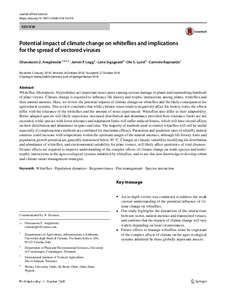| dc.contributor.author | Aregbesola, O.Z. |
| dc.contributor.author | Legg, J.P. |
| dc.contributor.author | Sigsgaard, L. |
| dc.contributor.author | Lund, O.S. |
| dc.contributor.author | Rapisarda, C. |
| dc.date.accessioned | 2019-12-04T11:30:16Z |
| dc.date.available | 2019-12-04T11:30:16Z |
| dc.date.issued | 2018 |
| dc.identifier.citation | Aregbesola, O.Z., Legg, J.P., Sigsgaard, L., Lund, O.S. & Rapisarda, C. (2018). Potential impact of climate change on whiteflies and implications for the spread of vectored viruses. Journal of Pest Science, 1-12. |
| dc.identifier.issn | 1612-4758 |
| dc.identifier.uri | https://hdl.handle.net/20.500.12478/5243 |
| dc.description | Published online: 31 Oct 2018 |
| dc.description.abstract | Whiteflies (Hemiptera: Aleyrodidae) are important insect pests causing serious damage to plants and transmitting hundreds of plant viruses. Climate change is expected to influence life history and trophic interactions among plants, whiteflies and their natural enemies. Here, we review the potential impacts of climate change on whiteflies and the likely consequences for agricultural systems. This review concludes that while climatic stress tends to negatively affect life history traits, the effects differ with the tolerance of the whiteflies and the amount of stress experienced. Whiteflies also differ in their adaptability. Better adapted species will likely experience increased distribution and abundance provided their tolerance limits are not exceeded, while species with lower tolerance and adaptation limits will suffer reduced fitness, which will have overall effects on their distribution and abundance in space and time. The majority of methods used to control whiteflies will still be useful especially if complementary methods are combined for maximum efficacy. Parasitism and predation rates of whitefly natural enemies could increase with temperature within the optimum ranges of the natural enemies, although life history traits and population growth potential are generally maximised below 30 °C. Changes in climatic suitability modifying the distribution and abundance of whiteflies, and environmental suitability for plant viruses, will likely affect epidemics of viral diseases. Greater efforts are required to improve understanding of the complex effects of climate change on multi-species and multi-trophic interactions in the agro-ecological systems inhabited by whiteflies, and to use this new knowledge to develop robust and climate-smart management strategies. |
| dc.description.sponsorship | European Union |
| dc.format.extent | 1-12 |
| dc.language.iso | en |
| dc.rights | All rights reserved; no re-use allowed |
| dc.subject | Hemiptera |
| dc.subject | Begomovirus |
| dc.subject | Integrated Pest Management |
| dc.subject | Greenhouses |
| dc.subject | Climate Change |
| dc.subject | Insect Pest |
| dc.subject | Whiteflies |
| dc.title | Potential impact of climate change on whiteflies and implications for the spread of vectored viruses |
| dc.type | Journal Article |
| dc.description.version | Peer Review |
| cg.contributor.crp | Climate Change, Agriculture and Food Security |
| cg.contributor.affiliation | Università degli Studi di Catania |
| cg.contributor.affiliation | University of Copenhagen |
| cg.contributor.affiliation | International Institute of Tropical Agriculture |
| cg.contributor.affiliation | Wesley University Ondo |
| cg.coverage.region | Acp |
| cg.coverage.region | Asia |
| cg.coverage.region | East Asia |
| cg.coverage.region | Europe |
| cg.coverage.country | China |
| cg.coverage.country | Finland |
| cg.coverage.country | Peru |
| cg.coverage.country | Spain |
| cg.creator.identifier | James Legg: 0000-0003-4140-3757 |
| cg.creator.identifier | Carmelo Rapisarda: 0000-0002-0824-9797 |
| cg.researchtheme | PLANT PRODUCTION & HEALTH |
| cg.isijournal | ISI Journal |
| cg.authorship.types | CGIAR and developing country institute |
| cg.iitasubject | Climate Change |
| cg.iitasubject | Pests Of Plants |
| cg.journal | Journal of Pest Science |
| cg.howpublished | Formally Published |
| cg.accessibilitystatus | Limited Access |
| local.dspaceid | 103280 |
| cg.targetaudience | Scientists |
| cg.identifier.doi | https://dx.doi.org/10.1007/s10340-018-1059-9 |

